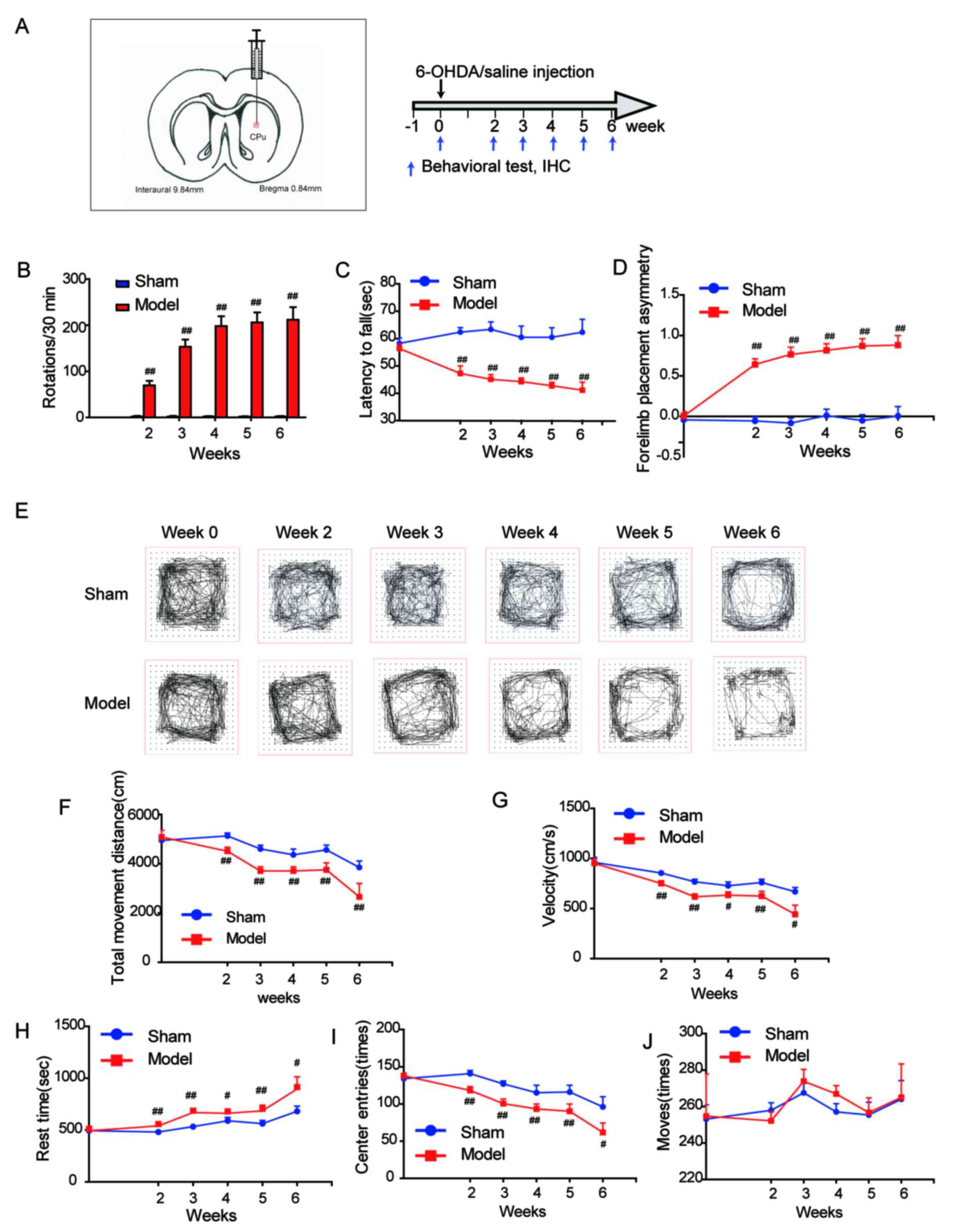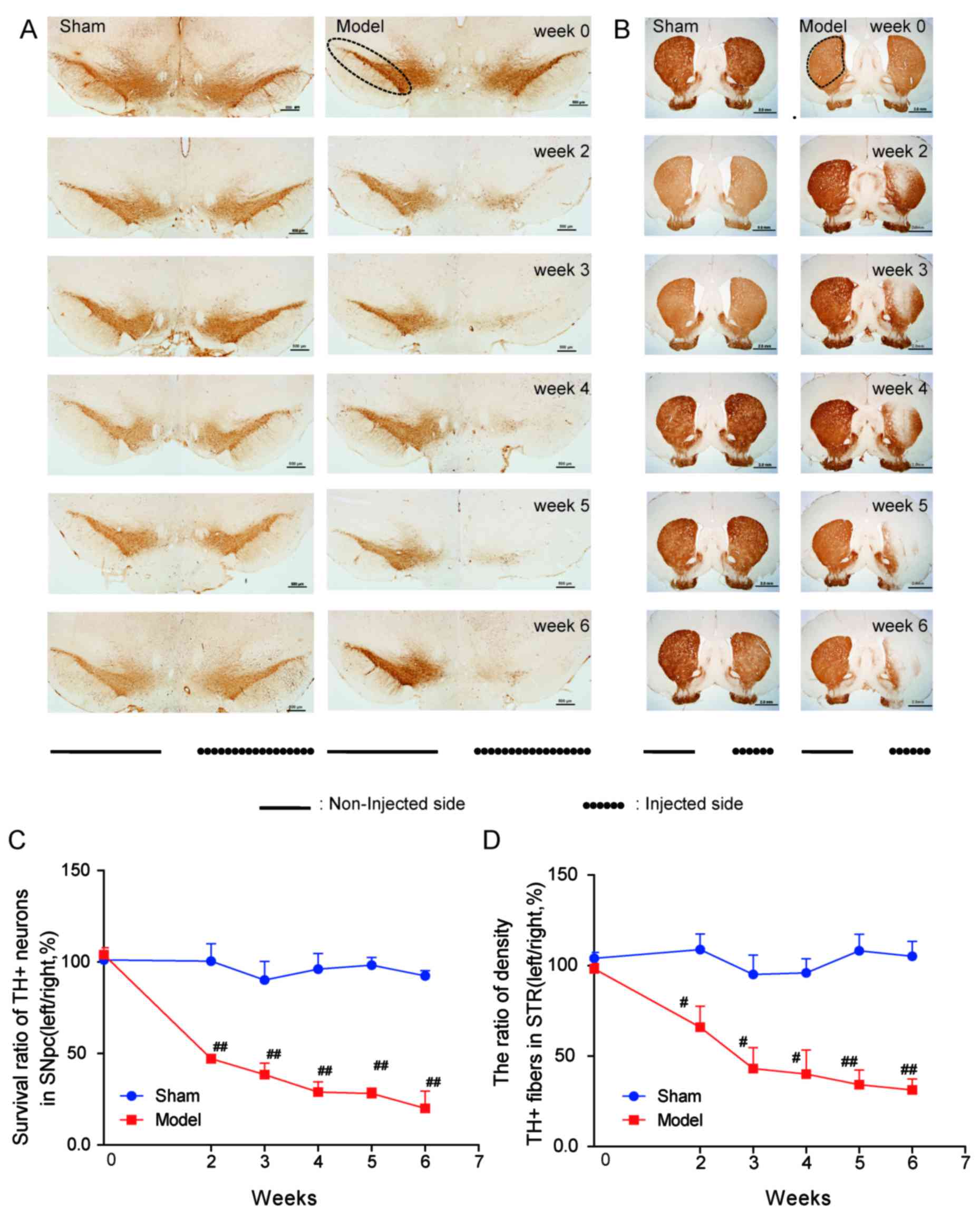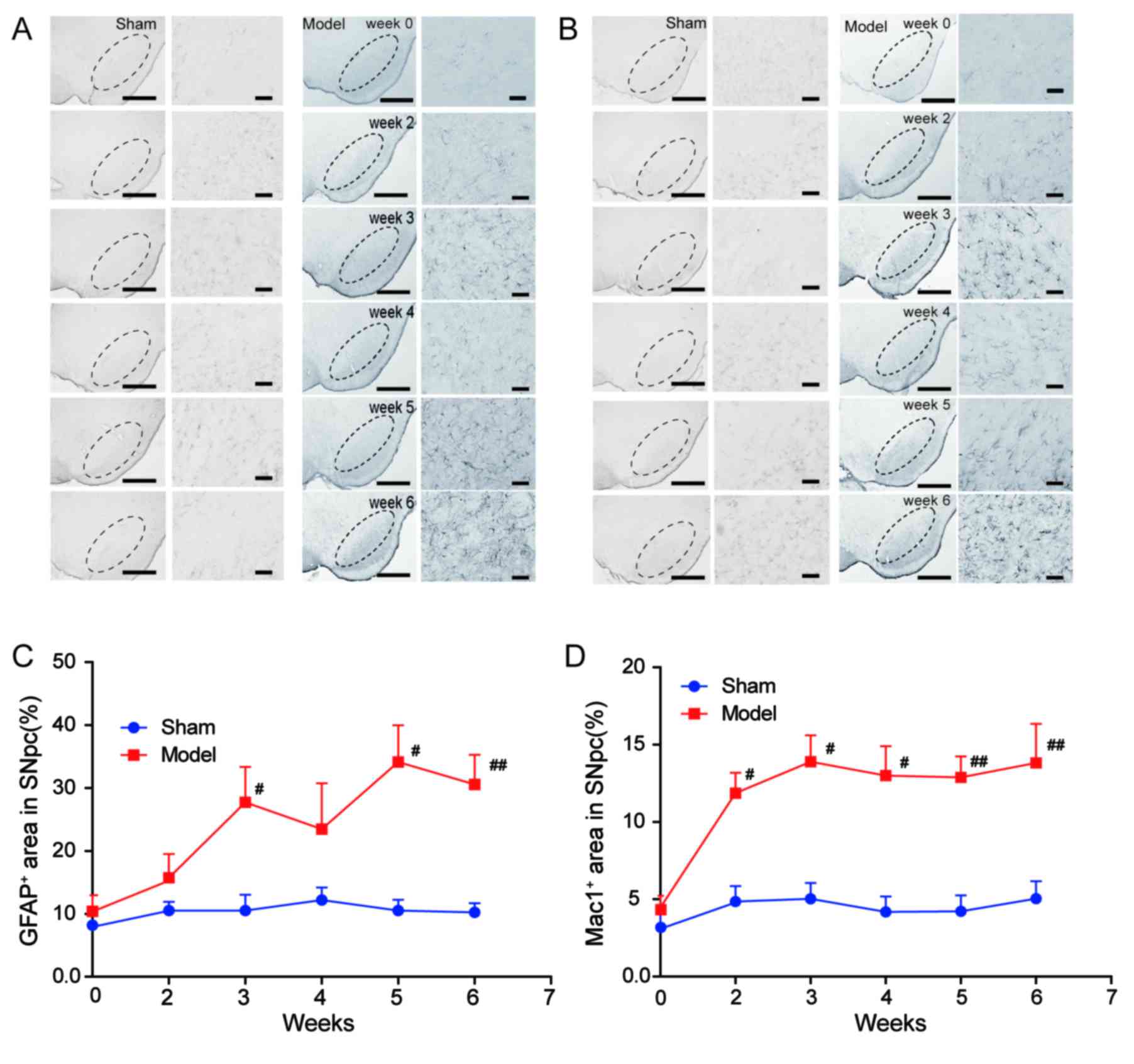|
1
|
Redgrave P, Vautrelle N and Reynolds JN:
Functional properties of the basal ganglia's re-entrant loop
architecture: Selection and reinforcement. Neuroscience.
198:138–151. 2011. View Article : Google Scholar : PubMed/NCBI
|
|
2
|
Su X and Federoff HJ: Immune responses in
Parkinson's disease: Interplay between central and peripheral
immune systems. Biomed Res Int. 2014:2751782014. View Article : Google Scholar : PubMed/NCBI
|
|
3
|
Jackson-Lewis V, Blesa J and Przedborski
S: Animal models of Parkinson's disease. Parkinsonism Relat Disord.
18 Suppl 1:S183–S185. 2012. View Article : Google Scholar : PubMed/NCBI
|
|
4
|
Ungerstedt U: 6-Hydroxy-dopamine induced
degeneration of central monoamine neurons. Eur J Pharmacol.
5:107–110. 1968. View Article : Google Scholar : PubMed/NCBI
|
|
5
|
Blandini F, Armentero MT and Martignoni E:
The 6-hydroxydopamine model: News from the past. Parkinsonism Relat
Disord. 14 Suppl 2:S124–S129. 2008. View Article : Google Scholar : PubMed/NCBI
|
|
6
|
Lee CS, Sauer H and Bjorklund A:
Dopaminergic neuronal degeneration and motor impairments following
axon terminal lesion by instrastriatal 6-hydroxydopamine in the
rat. Neuroscience. 72:641–653. 1996. View Article : Google Scholar : PubMed/NCBI
|
|
7
|
Bové J and Perier C: Neurotoxin-based
models of Parkinson's disease. Neuroscience. 211:51–76. 2012.
View Article : Google Scholar : PubMed/NCBI
|
|
8
|
Meredith GE and Kang UJ: Behavioral models
of Parkinson's disease in rodents: A new look at an old problem.
Mov Disord. 21:1595–1606. 2006. View Article : Google Scholar : PubMed/NCBI
|
|
9
|
Paxinos G and Watson C: The Rat Brain in
Stereotaxic Coordinates. Academic Press; 2005
|
|
10
|
Przedborski S, Levivier M, Jiang H,
Ferreira M, Jacksonlewis V, Donaldson D and Togasaki DM:
Dose-dependent lesions of the dopaminergic nigrostriatal pathway
induced by intrastriatal injection of 6-hydroxydopamine.
Neuroscience. 67:631–647. 1995. View Article : Google Scholar : PubMed/NCBI
|
|
11
|
Monville C, Torres EM and Dunnett SB:
Comparison of incremental and accelerating protocols of the rotarod
test for the assessment of motor deficits in the 6-OHDA model. J
Neurosci Methods. 158:219–223. 2006. View Article : Google Scholar : PubMed/NCBI
|
|
12
|
Landers MR, Kinney JW and van Breukelen F:
Forced exercise before or after induction of 6-OHDA-mediated
nigrostriatal insult does not mitigate behavioral asymmetry in a
hemiparkinsonian rat model. Brain Res. 1543:263–270. 2014.
View Article : Google Scholar : PubMed/NCBI
|
|
13
|
Yuan HL, Li B, Xu J, Wang Y, He Y, Zheng Y
and Wang XM: Tenuigenin protects dopaminergic neurons from
inflammation-mediated damage induced by the lipopolysaccharide. CNS
Neurosci Ther. 18:584–590. 2012. View Article : Google Scholar : PubMed/NCBI
|
|
14
|
van der Perren A, Macchi F, Toelen J,
Carlon MS, Maris M, de Loor H, Kuypers DR, Gijsbers R, Van den
Haute C, Debyser Z and Baekelandt V: FK506 reduces
neuroinflammation and dopaminergic neurodegeneration in an
α-synuclein-based rat model for Parkinson's disease. Neurobiol
Aging. 36:1559–1568. 2015. View Article : Google Scholar : PubMed/NCBI
|
|
15
|
Sanchez-Guajardo V, Febbraro F, Kirik D
and Romero-Ramos M: Microglia acquire distinct activation profiles
depending on the degree of alpha-synuclein neuropathology in a rAAV
based model of Parkinson's disease. PLoS One. 5:e87842010.
View Article : Google Scholar : PubMed/NCBI
|
|
16
|
McGeer PL and McGeer EG: Glial reactions
in Parkinson's disease. Mov Disord. 23:474–483. 2008. View Article : Google Scholar : PubMed/NCBI
|
|
17
|
Mendez JS and Finn BW: Use of
6-hydroxydopamine to create lesions in catecholamine neurons in
rats. Neurosurg. 42:166–173. 1975. View Article : Google Scholar
|
|
18
|
Stott SR and Barker RA: Time course of
dopamine neuron loss and glial response in the 6-OHDA striatal
mouse model of Parkinson's disease. Eur J Neurosci. 39:1042–1056.
2014. View Article : Google Scholar : PubMed/NCBI
|
|
19
|
Schlachetzki JC, Marxreiter F,
Regensburger M, Kulinich A, Winner B and Winkler J: Increased
tyrosine hydroxylase expression accompanied by glial changes within
the non-lesioned hemisphere in the 6-hydroxydopamine model of
Parkinson's disease. Restor Neurol Neurosci. 32:447–462.
2014.PubMed/NCBI
|
|
20
|
Walsh S, Finn DP and Dowd E: Time-course
of nigrostriatal neurodegeneration and neuroinflammation in the
6-hydroxydopamine-induced axonal and terminal lesion models of
Parkinson's disease in the rat. Neuroscience. 175:251–261. 2011.
View Article : Google Scholar : PubMed/NCBI
|
|
21
|
Sauer H and Oertel WH: Progressive
degeneration of nigrostriatal dopamine neurons following
intrastriatal terminal lesions with 6-hydroxydopamine: A combined
retrograde tracing and immunocytochemical study in the rat.
Neuroscience. 59:401–415. 1994. View Article : Google Scholar : PubMed/NCBI
|
|
22
|
Marti MJ, Saura J, Burke RE, Jackson-Lewis
V, Jiménez A, Bonastre M and Tolosa E: Striatal 6-hydroxydopamine
induces apoptosis of nigral neurons in the adult rat. Brain Res.
958:185–191. 2002. View Article : Google Scholar : PubMed/NCBI
|
|
23
|
Marti MJ, James CJ, Oo TF, Kelly WJ and
Burke RE: Early developmental destruction of terminals in the
striatal target induces apoptosis in dopamine neurons of the
substantia nigra. J Neurosci. 17:2030–2039. 1997.PubMed/NCBI
|
|
24
|
Prut L and Belzung C: The open field as a
paradigm to measure the effects of drugs on anxiety-like behaviors:
A review. Eur J Pharmacol. 463:3–33. 2003. View Article : Google Scholar : PubMed/NCBI
|
|
25
|
Blandini F, Levandis G, Bazzini E, Nappi G
and Armentero MT: Time-course of nigrostriatal damage, basal
ganglia metabolic changes and behavioural alterations following
intrastriatal injection of 6-hydroxydopamine in the rat: New clues
from an old model. Eur J Neurosci. 25:397–405. 2007. View Article : Google Scholar : PubMed/NCBI
|
|
26
|
Mosley RL, Benner EJ, Kadiu I, Thomas M,
Boska MD, Hasan K, Laurie C and Gendelman HE: Neuroinflammation,
oxidative stress and the pathogenesis of Parkinson's disease. Clin
Neurosci Res. 6:261–281. 2006. View Article : Google Scholar : PubMed/NCBI
|
|
27
|
Vivekanantham S, Shah S, Dewji R, Dewji A,
Khatri C and Ologunde R: Neuroinflammation in Parkinson's disease:
Role in neurodegeneration and tissue repair. Int J Neurosci.
125:717–725. 2015. View Article : Google Scholar : PubMed/NCBI
|
|
28
|
Depino AM, Earl C, Kaczmarczyk E, Ferrari
C, Besedovsky H, del Rey A, Pitossi FJ and Oertel WH: Microglial
activation with atypical proinflammatory cytokine expression in a
rat model of Parkinson's disease. Eur J Neurosci. 18:2731–2742.
2003. View Article : Google Scholar : PubMed/NCBI
|














